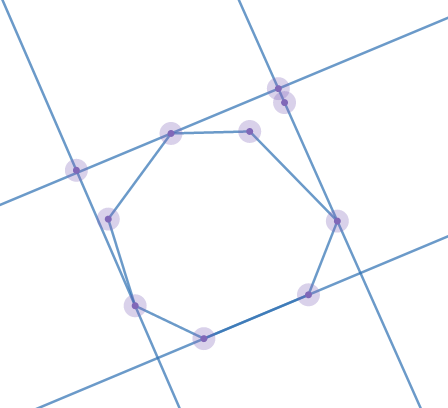【题解】UVA10173 Smallest Bounding Rectangle
题意
给定多组数据,每组数据给定个坐标,求能覆盖这个点的最小矩形,并输出其面积。
思路
其实这道题跟P3187 [HNOI2007]最小矩形覆盖并没有多大的区别,而且也省去了求矩形顶点坐标的步骤,(当时内心是非常开心,但发现这数据比P3187强得多的时候,内心是崩溃的。。。),但这道题显然数据是强得太多了,我一份A了P3187的代码并没有过不了这道题。。(我后来改了一下找左边点时的旋转方向好像就A了)想要比较强的数据的话可以上这里。
对于最小矩形覆盖,其最小矩形的一条边必定在这个点的凸包上,这样我们就先求出凸包再使用旋转卡壳,找到在以当前边为矩形的一条边时,在最左边,最右边,最上边的点,然后用向量加减的方法求出矩形的高和宽,再进一步求面积就好了。

(别忘了会出现最小矩形覆盖无解的情况)。
Code
#include<bits/stdc++.h>
#define double long double
#define eps 1e-18
using namespace std;
const int maxn=5e4+10;
struct geometric {
double x, y;
geometric(double X=0, double Y=0) :x(X), y(Y) {}
friend geometric operator + (const geometric a, const geometric b) { return geometric(a.x+b.x, a.y+b.y); }
friend geometric operator - (const geometric a, const geometric b) { return geometric(a.x-b.x, a.y-b.y); }
friend geometric operator * (const geometric a, double p) { return geometric(a.x*p, a.y*p); }
friend geometric operator / (const geometric a, double p) { return geometric(a.x/p, a.y/p); }// 向量的四则运算
}p[maxn], st[maxn];
int n, cnt, top;double S=1e20;
double dis(geometric a, geometric b) { return sqrt((a.x-b.x)*(a.x-b.x)+(a.y-b.y)*(a.y-b.y)); } // 向量模长
double dot(geometric a1, geometric a2, geometric b1, geometric b2) { return (a2.x-a1.x)*(b2.x-b1.x)+(a2.y-a1.y)*(b2.y-b1.y); }// 点积
double cross(geometric a1, geometric a2, geometric b1, geometric b2) { return (a2.x-a1.x)*(b2.y-b1.y)-(a2.y-a1.y)*(b2.x-b1.x); } // 叉积
bool cmp(geometric a, geometric b)
{
double tmp;
tmp=cross(p[1], a, p[1], b);
if(tmp>0)return true;
if(tmp==0)return dis(p[1], a)<=dis(p[1], b);
return false;
}
int main()
{
while(true)
{
memset(st,0,sizeof(st));
memset(p,0,sizeof(p));
scanf("%d", &n);
if(n==0)break;
top=0;cnt=0;S=1e20;
for(int i=1;i<=n;i++)
{
double x, y;
scanf("%Lf%Lf", &x, &y);
p[++cnt]=geometric(x, y);
if(i==1)
continue;
if(p[cnt].y<p[1].y)
swap(p[cnt], p[1]);
if(p[cnt].y==p[1].y&&p[cnt].x>p[1].x)
swap(p[cnt], p[1]);
}
sort(p+2, p+cnt+1, cmp);
st[++top]=p[1];
for(int i=2;i<=cnt;i++)
{
while(top>1&&cross(st[top-1], st[top], st[top], p[i])<=0)
top--;
st[++top]=p[i];
}
st[++top]=p[1];
// 求凸包
if(top<=3)
{
printf("0.0000\n");
continue;
}
// 凸包顶点只有两个时,最小矩形覆盖无解。
st[0]=st[top-1];
for(int i=2, j=3,l,r;i<=top;i++)
{
r=(i==top)?1:i;l=i-1;
while(cross(st[i-1], st[i], st[i], st[j])<cross(st[i-1], st[i], st[i], st[j+1]))
j=(j==top-1)?1:j+1;
// 找最上边的点
while(dot(st[i-1], st[i], st[i], st[r])<dot(st[i-1], st[i], st[i], st[r+1]))
r=(r==top-1)?1:r+1;
// 找最右边的点
while(dot(st[i], st[i-1], st[i-1], st[l])<dot(st[i], st[i-1], st[i-1], st[l-1]))
l=(l==1)?top-1:l-1;
// 找最左边的点
double wide, high, len=dis(st[i-1], st[i]);
wide=fabs(dot(st[i], st[i-1], st[i-1], st[l]))/len+fabs(dot(st[i-1], st[i], st[i], st[r]))/len+len; // 宽
high=fabs(cross(st[i-1], st[i], st[i-1], st[j]))/len; // 高
S=min(S, high*wide);
}
printf("%.4Lf\n", S);
}
return 0;
}
感谢观看!!!
Doctor,您还有许多事情需要处理。现在还不能休息哦。



【推荐】国内首个AI IDE,深度理解中文开发场景,立即下载体验Trae
【推荐】编程新体验,更懂你的AI,立即体验豆包MarsCode编程助手
【推荐】抖音旗下AI助手豆包,你的智能百科全书,全免费不限次数
【推荐】轻量又高性能的 SSH 工具 IShell:AI 加持,快人一步
· 地球OL攻略 —— 某应届生求职总结
· 周边上新:园子的第一款马克杯温暖上架
· Open-Sora 2.0 重磅开源!
· 提示词工程——AI应用必不可少的技术
· .NET周刊【3月第1期 2025-03-02】